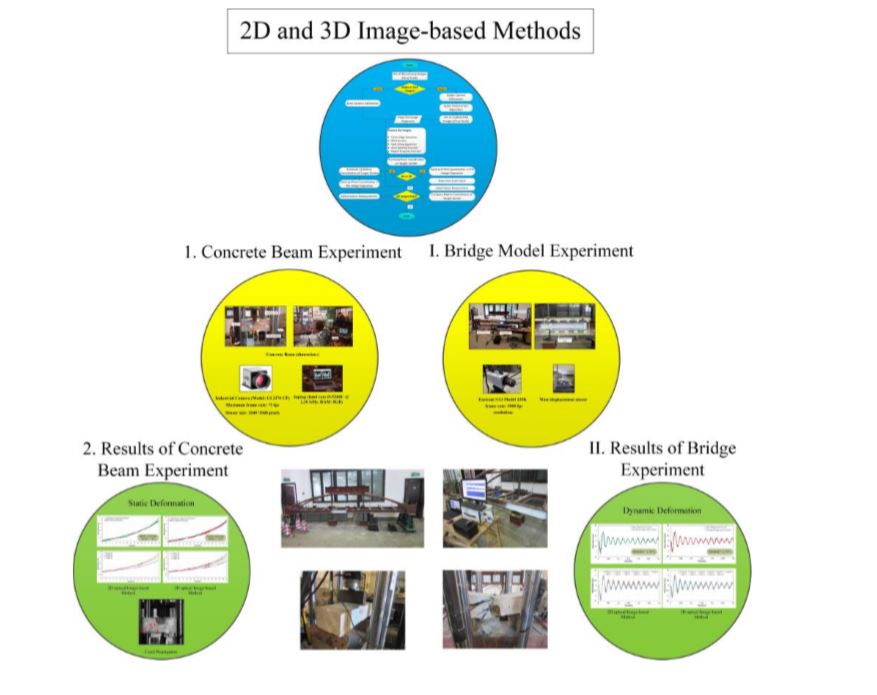Video Article Open Access
Experimental Evaluation of Deformation of Transport Infrastructures using Image-based Methods
Vahid Abolhasannejad1,*, Said Easa1, Shuai Dong2, Xiaoming Hunag3, Panjie Li4
1Department of Civil Engineering, Ryerson University, Toronto, ON, M5B 2K3 Canada
2School of Civil Engineering, Changsha University of Science and Technology, Changsha 410114, China
3School of Transportation, Southeast University, Nanjing 211189, China
4School of Civil Engineering, Zhengzhou University, Zhengzhou, 450001, China
Vid. Proc. Adv. Mater., Volume 2, Article ID 2021-0148 (2021)
DOI: 10.5185/vpoam.2021.0148
Publication Date (Web): 20 Jan 2021
Copyright © IAAM
Graphical Abstract

Abstract
Structural deformation is one of the main factors to determine the behavioural characteristics of transport infrastructures such as bridges and slab tracks. Knowing about these characteristics would help in designing safer and more durable structures. Thus far, different deformation measurement methods have been developed. Conventional methods including numerical and contact-based methods have been used for decades to measure structural deformation. High technology devices such as global positioning system (GPS), radar, light detection and ranging (Lidar), and vision-based methods have been recently utilized as the noncontact-based method for measurement of deformation properties [1-5]. Among all these methods, image-based method is of several advantages compared with other solutions for measurement of structures deformation due to its convenience, cost effectiveness, time effectiveness, and remotely measurement procedure. In this study, the proposed optical image-based systems consisted of two main components: Image data acquisition platform and image processing and analysis toolbox. The first component included cameras and their accessories, targets, checkerboard, computer, and image acquisition software. Two types of cameras including industrial cameras and high-speed cameras were utilized to test their performance and efficiency. The second component is composed of various kinds of algorithms and approaches that are used to extract the necessary information from images for camera calibration and target detection and tracking by analysis of image sequence. Two 2D and 3D optical image-based methods were developed to measure both static and dynamic deformation of the structures. In these methods, two different camera configuration systems (single and dual camera configuration) were installed and evaluated. Two experiments including concrete beam and bridge model tests were conducted to investigate the accuracy and performance of the proposed 2D and 3D optical image-based methods. In the concrete beam test, the static load was applied at the top center point of the beam while in the bridge test, the structure was undergone the dynamic load. Subsequently, both static and dynamic deformation were measured and estimated at different points. Four different scenarios have been investigated based on the experimental design. All the measurement scenarios led to accurate estimation of deformation that indicates the accuracy and efficiency of both 2D and 3D optical image-based methods for measurement of both static and dynamic deformation. The results showed that 3D optical image-based method achieved the highest accuracy for estimation of both static and dynamic deformation that shows dual camera configuration is more accurate than single camera configuration in this case. Although the 3D optical image-based method is of higher accuracy, it might need more equipment, more time, and more cost to be implemented. As for the camera type, higher accuracy was achieved using industrial cameras that might be because of its higher image resolution.
Keywords
Static and dynamic deformations, measurement, transport infrastructure, Image-based method.
Acknowledgement
This research study was supported by China Scholarship Council (Award No. 2011DFH997) and the Natural Sciences and Engineering Research Council of Canada (NSERC) Engage program (Award No: 544072-19).
References
- S. Yu, and J. Zhang; Computer‐Aided Civil and Infrastructure Engineering, 2020, 35, 3.
- L. Sun, V. Abolhasannejad, L. Gao, Y. Li; Measurement, 2016, 85, 100-117.
- V. Abolhasannejad, X. Huang, N. Namazi; Sensors, 2018, 19, 9, 2754.
- H. H. Handayani, M. Taufik; Procedia Environmental Sciences, 2015, 24, 266-276.
- W. Liu, S. E.Chen, D. Boyajian, E. Hauser; Materials Evaluation, 2010, 68, 12, 1359-67.
Biography
Vahid Abolhasannejad is currently a postdoctoral research fellow at Department of Civil Engineering, Ryerson University. He is currently working on the project entitled “Development of Optical Sensing Detection System for Monitoring of Rutting and Pavement Assessment” which is a joint project between Ryerson University and WSP Canada that is being supported by the National Sciences and Engineering Research Council of Canada (NSERC). Dr. Abolhasannejad received a research Grant award from MITACS in Canada last year. This grant aimed to develop a remote monitoring system for fatigue/drowsiness detection at the early stage using wearable sensor devices through collaborating with Myant Inc., which is a leading Canadian company in innovating, designing, and producing textile-based biomedical connected systems. In addition, he has started to work on innovative ideas regarding the solutions for preventing COVID-19 pandemic using biomarker signal processing and analysis. Three main areas of Structural Health Monitoring, Highway Safety, and Biomedical Engineering Systems are among his research fields of interest. He currently lives in Toronto beside the beautiful lake of Ontario. His favorite extra activities are camping, traveling, and playing soccer and Ping Pong.
Video Proceedings of Advanced Materials

Upcoming Congress



